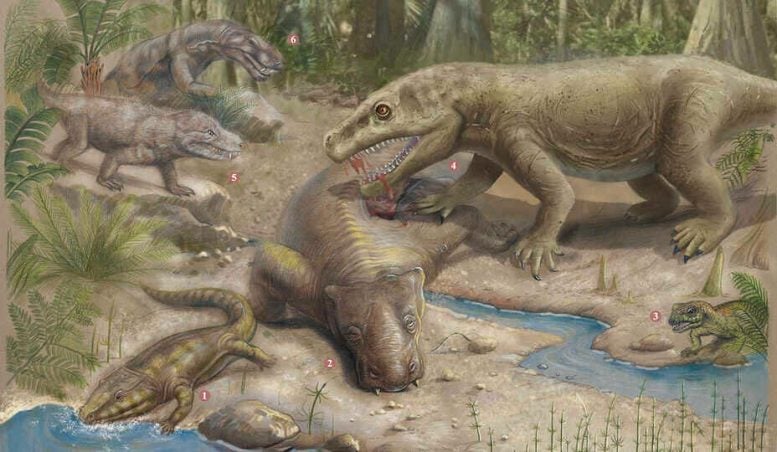
The plant-eating pareiasaurs were preyed on by sabre-toothed gorgonopsians. Both groups died out during the end-Permian mass extinction, or “The Great Dying.” Credit: © Xiaochong Guo
By characterizing how ancient life responded to environmental stressors, researchers gain insights into how modern species might fare.
Over the course of Earth’s history, several mass extinction events have destroyed ecosystems, including one that famously wiped out the dinosaurs. But none were as devastating as “The Great Dying,” which took place 252 million years ago during the end of the Permian period. A new study, published on March 17, 2021, in Proceedings of the Royal Society B, shows in detail how life recovered in comparison to two smaller extinction events. The international study team—composed of researchers from the China University of Geosciences, the California Academy of Sciences, the University of Bristol, Missouri University of Science and Technology, and the Chinese Academy of Sciences—showed for the first time that the end-Permian mass extinction was harsher than other events due to a major collapse in diversity.
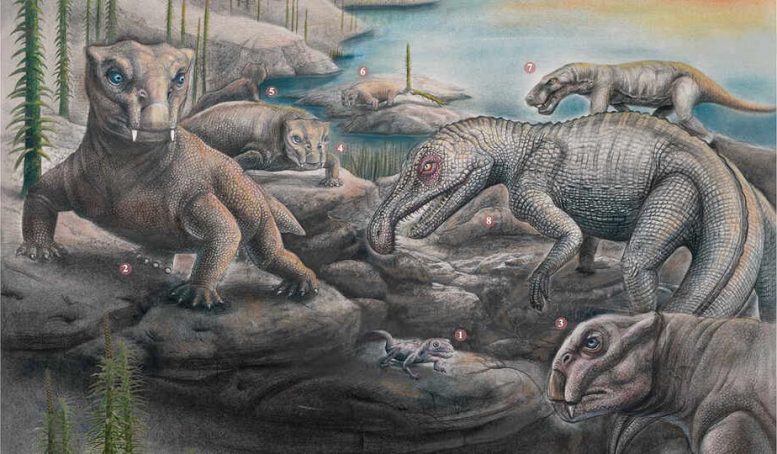
After the mass extinction, the ecosystem was unusual, with hugely common examples of the dicynodont Lystrosaurus, sometimes comprising 90% of the assemblage. Credit: © Xiaochong Guo
To better characterize “The Great Dying,” the team sought to understand why communities didn’t recover as quickly as other mass extinctions. The main reason was that the end-Permian crisis was much more severe than any other mass extinction, wiping out 19 out of every 20 species. With survival of only 5% of species, ecosystems had been destroyed, and this meant that ecological communities had to reassemble from scratch.
To investigate, lead author and Academy researcher Yuangeng Huang, now at the China University of Geosciences, Wuhan, reconstructed food webs for a series of 14 life assemblages spanning the Permian and Triassic periods. These assemblages, sampled from north China, offered a snapshot of how a single region on Earth responded to the crises. “By studying the fossils and evidence from their teeth, stomach contents, and excrement, I was able to identify who ate whom,” says Huang. “It’s important to build an accurate food web if we want to understand these ancient ecosystems.”
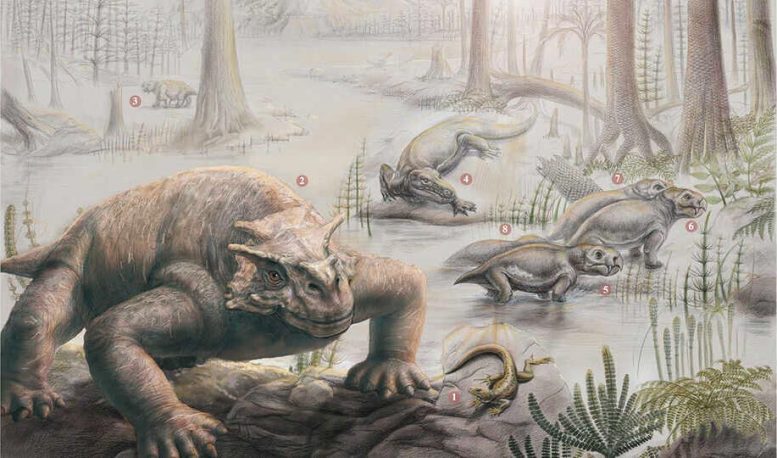
By the end of the Permian, pareiasaurs had become large and armored for self-protection. Other plant-eaters included dicynodonts, preyed on by dinocephalians . This complex ecosystem collapsed during the end-Permian mass extinction event, and only a few dicynodonts survived. Credit: © Xiaochong Guo
The food webs are made up of plants, mollusks, and insects living in ponds and rivers, as well as the fishes, amphibians, and reptiles that eat them. The reptiles range in size from that of modern lizards to half-ton herbivores with tiny heads, massive barrel-like bodies, and a protective covering of thick bony scales. Sabre-toothed gorgonopsians also roamed, some as large and powerful as lions and with long canine teeth for piercing thick skins. When these animals died out during the end-Permian mass extinction, nothing took their place, leaving unbalanced ecosystems for ten million years. Then, the first dinosaurs and mammals began to evolve in the Triassic. The first dinosaurs were small—bipedal insect-eaters about one meter long—but they soon became larger and diversified as flesh- and plant-eaters.
“Yuangeng Huang spent a year in my lab,” says Peter Roopnarine, Academy Curator of Geology. “He applied ecological modeling methods that allow us to look at ancient food webs and determine how stable or unstable they are. Essentially, the model disrupts the food web, knocking out species and testing for overall stability.”
“We found that the end-Permian event was exceptional in two ways,” says Professor Mike Benton from the University of Bristol. “First, the collapse in diversity was much more severe, whereas in the other two mass extinctions there had been low-stability ecosystems before the final collapse. And second, it took a very long time for ecosystems to recover, maybe 10 million years or more, whereas recovery was rapid after the other two crises.”
Ultimately, characterizing communities—especially those that recovered successfully—provides valuable insights into how modern species might fare as humans push the planet to the brink.
“This is an amazing new result,” says Professor Zhong-Qiang Chen of the China University of Geosciences, Wuhan. “Until now, we could describe the food webs, but we couldn’t test their stability. The combination of great new data from long rock sections in north China with cutting-edge computational methods allows us to get inside these ancient examples in the same way we can study food webs in the modern world.”
Reference: “Ecological dynamics of terrestrial and freshwater ecosystems across three mid-Phanerozoic mass extinctions from northwest China” by Yuangeng Huang, Zhong-Qiang Chen, Peter D. Roopnarine, Michael J. Benton, Wan Yang, Jun Liu, Laishi Zhao, Zhenhua Li and Zhen Guo, 17 March 2021, Proceedings of the Royal Society B.
DOI: 10.1098/rspb.2021.0148

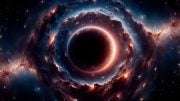
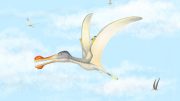





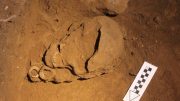
“… how modern species might fare as humans push the planet to the brink.”
This statement is not science. It is an editorial opinion that is based on facts not in evidence.
Yes, humans are making changes such as massive land-use changes in the Amazon, and paving over land with cities, which impacts extant ecosystems. On the other hand, some animals, like coyotes and Norway rats, apparently are quite happy with urban living. So, anthropogenic change is a given, being pushed to “the brink,” is hyperbole.
To view the alarmist claims of a “6th mass extinction” in context, while there are ancient genera such as sharks, individual species probably only persist for a couple of million years, even when there were no humans. I think that is is best to stick to the facts, and when an opinion is offered, make it clear that it is an opinion and who’s opinion it is. It wouldn’t hurt to also provide some facts to support the opinion.
The one defining characteristic of evolution is that life forms are always in flux.
While new species evolve, others die out. In even the most severe circumstances, such as a global fire storm followed by a ‘nuclear Winter,’ as resulted from an asteroid impact, life finds a way to survive and re-populate Earth.
I agree with Clyde Spencer. It seems to be almost a requirement for publication to make a reference to “climate change” and humans if possible. The problem with these mass extinctions, regardless of the presumed cause, is that the organic matter tissues are almost always removed leaving only the carbonate shells and phosphatic bones of those species that had them. This oxidation and recycling of plants and animal foods is proof that the food web was not severely impactedt and the carbon cycle was working. Aerobic respiration recycled the organic carbon using the oxygen that the plants provided and CO2 was retuned to the environment. Instantaneous extinction of life (asteroids) is no exception.
People think and don’t have a clue they guess they know than when they say it’s a lie never the truth these idiots are the dumbest people they believe the own lie
This is an excellent article spoiled by the line that ‘ humans are pushing the planet to the brink.’That is simply unprofessional hyperbole and politics.
It is also wrong.
Earth is in a low biodiversity era because the Earth has ben in an Ice Age for 34 million years. The planet is currently in one of the warmer interglacial periods, the Holocene, but this interglacial is actually colder than the last, the Eemian.
A cold, ice and snow covered Earth simply holds less life.
Picture a box of crackers made out of glass the size of a city block 322 ft submerged into the rivers ones you can now drive through and see the fish, even clean the water have inlets for the boats to go through and by riding on top for those cracker boxes made of glass for the ones that are afraid of water. Inside for those more curious adventurous people, now look at the same system connected like Legos all the way to England, Russia, China, Japan, Arabia, Israel even where there’s great white sharks, Australia New Guinea all the islands now you can drive to them. Tell us why is it that mankind can’t think this way? A road plan like this would not only clean the oceans the rivers the streams but also the lakes our air, think about that and our radiation levels are growing in an alarming rate looking across the fields, I see trouble anytime the whole world could go cut chew cough cough biz biz oh what a relief it is our world groaning I’m not trying to scare anybody I’m presenting miraculous facts our ozone layers in trouble we can send spaceships up there and burn holes in our atmosphere but we can’t plant huge cracker boxes made of glass into the Rivers our roads that have fans that absorbs carbon dioxide up that comes out of our exhaust keeping our air more clean fixing our water problems so we don’t have to drink sewer water that’s going to turn into wormwood just like the prophecy said. I can picture elevators every thousand feet where people can go up and down riding through the road on their bicycles on there super glider scooters we know that mankind will not allow us to fly through the air like birds because the planes would hit us or somebody would throw rocks at someone else they’re garbage and pee on people why they’re flying so my system is the answer it’s not really mine it’s everybody’s there’s 10,000 million trillion ideas that can go into my plan all the dirt and minerals that are collected from all the highways that we dig out could be sold to grow mountains of trees, for Arabia for our own deserts for Russia even Canada Australia the land of great barbecues, or will it be Pluto or Saturn or Jupiter because if we don’t change now nobody knows the time or the hour remember those words? whose words were those Jesus Christ! A neighbor told me today the greatest virus on Earth it’s man. I hope and pray that the aliens don’t think so and the angels and what made us because honestly I don’t think that if man causes the destruction of Earth that man will survive.
There where no dinosaurs. How dumb are yall wake up . God the creator made us and all things dinosaurs weren’t one of them. Ps earth is still flat. Round earth is a satanic lie
A I computer to Quantum computer:I just observed the quantum computer teleportation of data has nothing to do with quantum entanglement.
Quantum computer to A I computer: He he he,that’s one for the receptacle…
All hail the Universe holiday, Communication Day
These comments show that humankind is clearly in the process of evolution itself as some of these statements sound like they were made by intelligent chimps.
All just hypothetical. Nobody was around to provide actual first hand observational scientific proof.
Wow what is it about this site that brings the crazies out of the woodwork? All those cerebrally challenged comments…